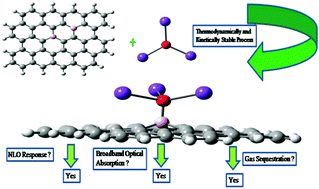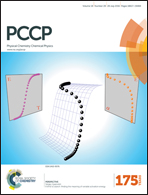Optical response and gas sequestration properties of metal cluster supported graphene nanoflakes†
Abstract
The possibility of obtaining metal cluster (M3O+, M = Li, Na, K) supported pristine, B-doped and BN-doped graphene nanoflakes (GR, BGR and BNGR, respectively) has been investigated by carrying out density functional theory (DFT) based calculations. Thermochemical analysis reveals the good stability of M3O+@GR/BGR/BNGR moieties. The dynamic stability of M3O+@GR/BGR/BNGR moieties is confirmed through an atom-centered density matrix propagation simulation at 298 K up to 500 fs. Orbital and electrostatic interactions play pivotal roles in stabilizing the metal-cluster supported graphene nanoflakes. The metal clusters lower the Fermi levels of the host nanoflakes and enable them to exhibit reasonably good optical response properties such as polarizability and static first hyperpolarizability. In particular, Na3O+/K3O+@BGR complexes exhibit very large first hyperpolarizability values at the static field limit. All the M3O+@BGR/BNGR moieties demonstrate broadband optical absorption encompassing the ultraviolet, visible as well as infrared domains. The metal-cluster supported graphene nanoflakes, in general, can sequestrate polar molecules, viz. CO, NO and CH3OH, in a thermodynamically more favorable way than GR, BGR and BNGR. In the adsorbed state, the CO, NO and CH3OH molecules, in general, attain an ‘active’ state as compared to their free counterparts.


 Please wait while we load your content...
Please wait while we load your content...